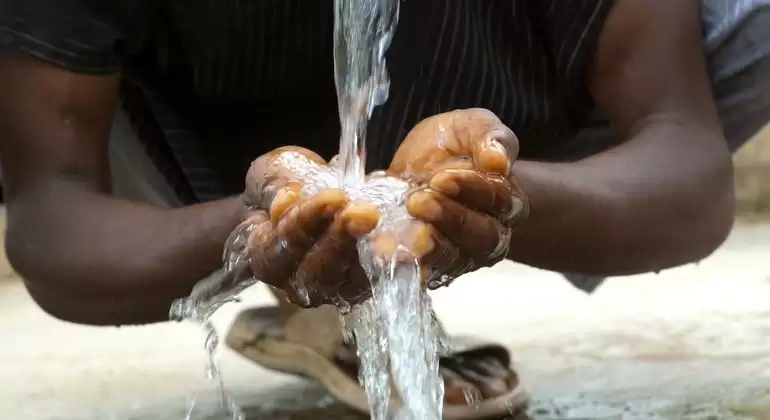India's Looming Water Crisis: A Threat to the Nation's Future!

By Rahi Bhide
Due to the large-scale use of water in many states of India, the groundwater level is decreasing day by day. If this continues like this, there is a possibility of a major crisis. Therefore, saving groundwater has become very important. In the states of Punjab, Haryana, Rajasthan, less water consumption will have to be started immediately. Compared to those states, looking at the situation in Maharashtra, since the groundwater level in Beed, Nagar, Solapur districts is in the rain shadow region, there is less rainfall and more extraction. New methods should be adopted to prevent water wastage in agriculture. Measures such as growing crops that require less water, storing rainwater in the soil, building lakes, planting trees, etc. will have to be taken. If not, a major water crisis may arise in the future. The government and the public will have to work together to solve this problem. Otherwise, many problems will arise for water in the future.
The Central Ground Water Board has recently released a report. Its name is ‘National Compilation on Dynamic Ground Water Resources of India.’ This report explains the status of groundwater in India. The report says that groundwater is being overused in many states of the country. Especially in Punjab, Haryana and Rajasthan, groundwater is depleting rapidly. 87 percent of the country’s groundwater is used for agriculture. Apart from this, groundwater is also used in homes and factories. According to this report, in 2024, 446.90 billion cubic meters (BCM) of groundwater returns to the ground every year in India. While the water here goes underground due to rainfall and other natural processes. From this, 406.19 ‘BCM’ of water can be extracted; however, this year 245.64 ‘BCM’ of water was extracted across the country. That is, an average of 60.47 percent of groundwater is being used in the country. Of this extracted water, 87 percent or 213.29 ‘BCM’ of water was used for agriculture. 11 percent or 28.07 'BCM' of water was used in homes and two percent or 4.28 'BCM' of water was used in factories. This makes it clear that the highest consumption of groundwater is in the agricultural sector. If this is not controlled, a major water problem may arise in the future. The report gives reasons for concern for some states. In these states, groundwater consumption is so high that more water is being extracted than the rainwater that is absorbed in the ground. Such states include Punjab, Haryana, Rajasthan, Delhi and Dadra Nagar Haveli and Daman Diu. In these places, groundwater consumption is more than one hundred percent. 6,746 places in the country were tested for groundwater. Out of these, the situation is very bad in 751 places. That is, in these 751 places, more water is being extracted than the amount of water that comes into the ground. This is 11.13 percent of the total places tested in the country. Apart from this, if we talk about 715 districts, then in 102 districts groundwater consumption is more than one hundred percent. Out of these 64 districts are in three states - Punjab, Haryana and Rajasthan. 19 out of 23 districts in Punjab, 16 out of 22 districts in Haryana and 29 out of 33 districts in Rajasthan are in this list. This shows how serious the groundwater situation is in these states.
Groundwater usage is very high in Punjab. In 2024, groundwater usage was 156.87 percent. That is, one and a half times more water is being extracted than the amount of water that enters the ground. According to the report, 19.19 ‘BCM’ of water returns to the ground every year in Punjab. Out of this, 17.63 ‘BCM’ of water can be extracted; however, this year 27.66 ‘BCM’ of water was extracted. Out of this extracted water, 26.24 ‘BCM’ of water was used for agriculture. Investigations were conducted in 153 places in Punjab. Out of which, the situation is very bad in 115 places. Sangrur district is at the forefront in this regard. The groundwater usage there is 313.24 percent. That is, three times the amount of water that enters the ground is being extracted. This is a matter of great concern. The situation is similar in Haryana. In Haryana, 143 places were investigated. Out of these, 88 places have high groundwater usage. That is, the situation is bad in 61.54 percent places. The highest 228.42 percent of water was extracted from Kurukshetra district. This shows that Haryana is also heavily dependent on groundwater for agriculture. If this continues, serious water shortage may arise. In Rajasthan, groundwater usage is 149.86 percent. Here, 12.58 ‘BCM’ of water comes into the ground every year. Out of this, 11.37 ‘BCM’ can be extracted; however, 17.05 ‘BCM’ of water was extracted. Out of this, 14.51 ‘BCM’ of water was used for agriculture. In Rajasthan, 302 places were investigated. Out of these, the situation is bad in 214 places. That is, 70.86 percent of places have high groundwater usage. The highest 228.42 percent of water was extracted from Jaisalmer district. This is the highest in the entire country. There is already water scarcity in Rajasthan. Moreover, the situation is getting worse due to overuse of groundwater.
In Tamil Nadu, an average of 74.26 percent of groundwater was used. This is not more than the national average; but in 9 districts it is more than 100 percent. Every year, 21.51 'BCM' of water comes into the ground. Out of this, 19.46 'BCM' can be extracted; however, 14.45 'BCM' of water was extracted. Out of this, 13.51 'BCM' of water was used for agriculture. Groundwater use is also a matter of concern in some other states. 6 districts in Madhya Pradesh, 5 districts in Uttar Pradesh, 5 districts in Karnataka, 4 districts in Gujarat and Hyderabad in Telangana have 100 percent groundwater use.
000
About The Author
Latest News
 The Digital-AI Tsunami in Creative Careers & Learning: Larger Possibilities Ahead!
The Digital-AI Tsunami in Creative Careers & Learning: Larger Possibilities Ahead!






.jpeg)





